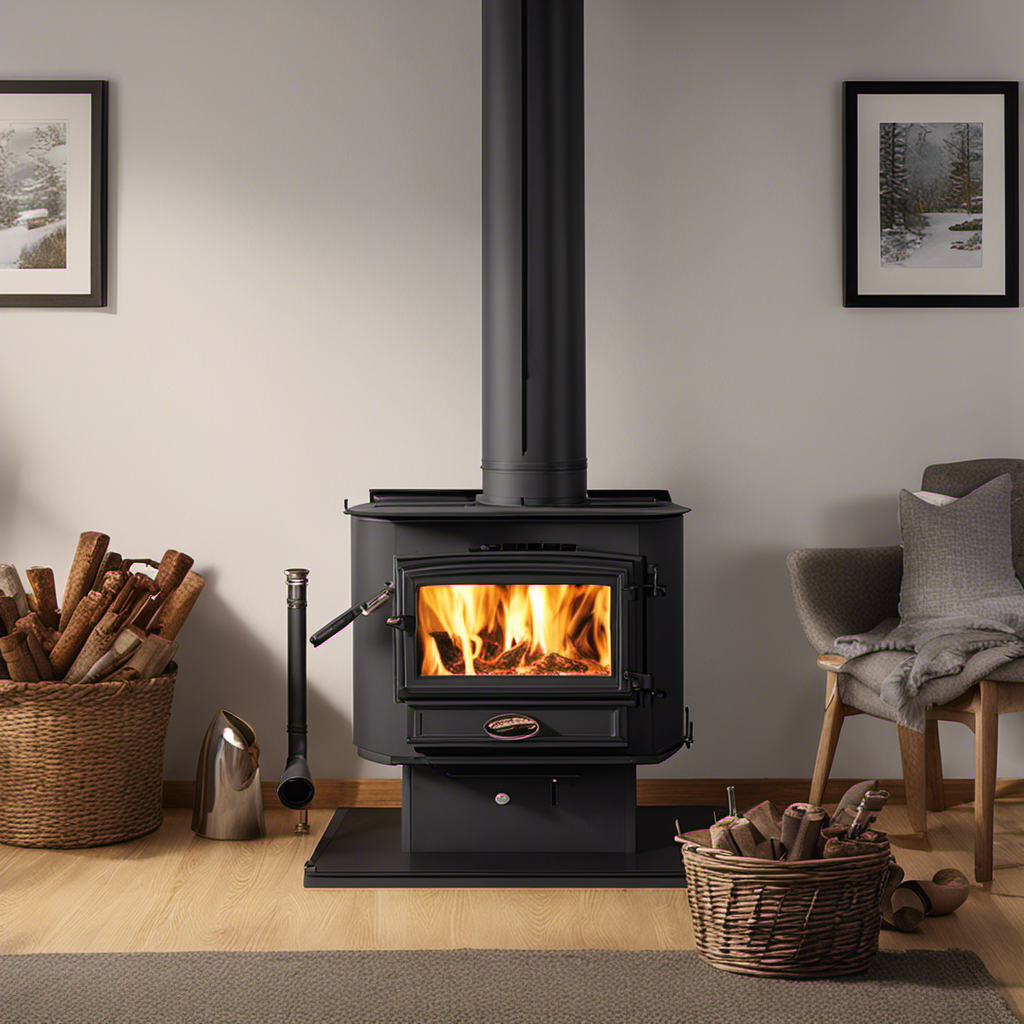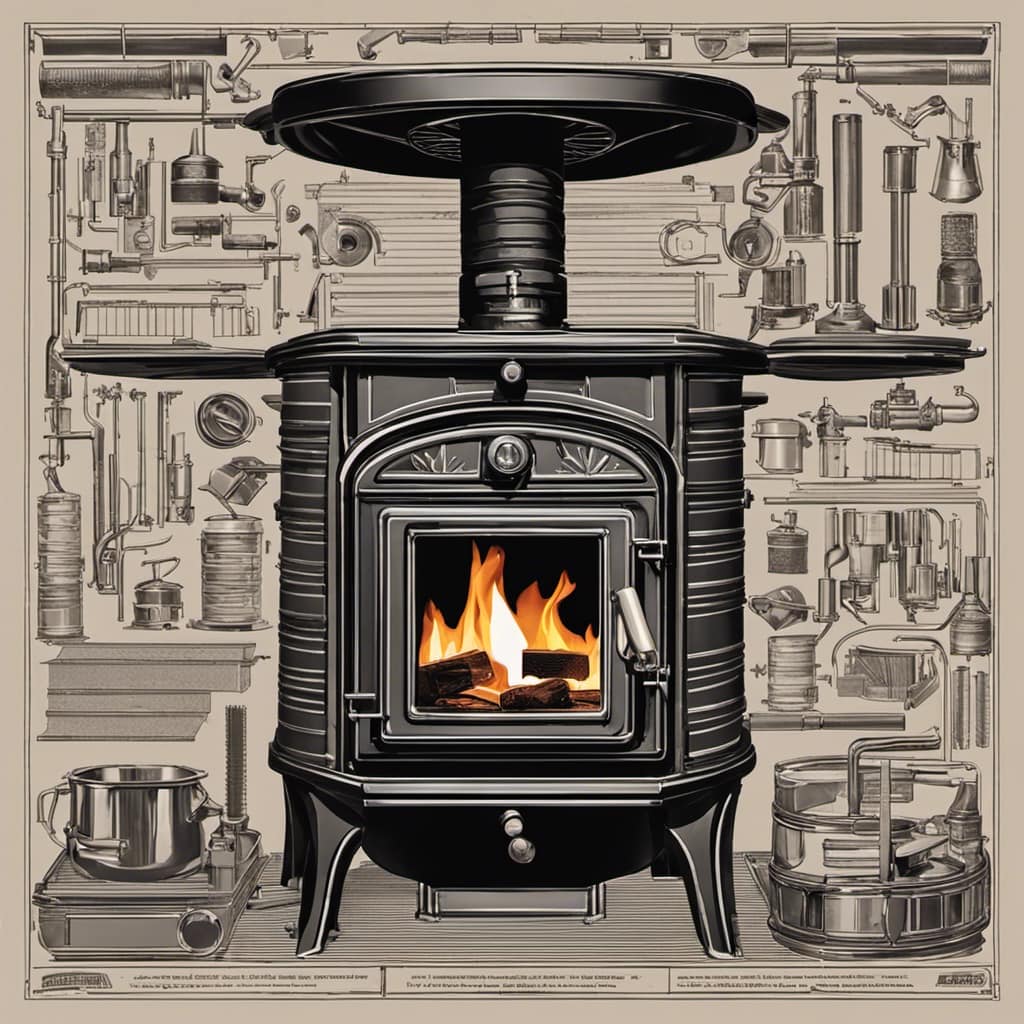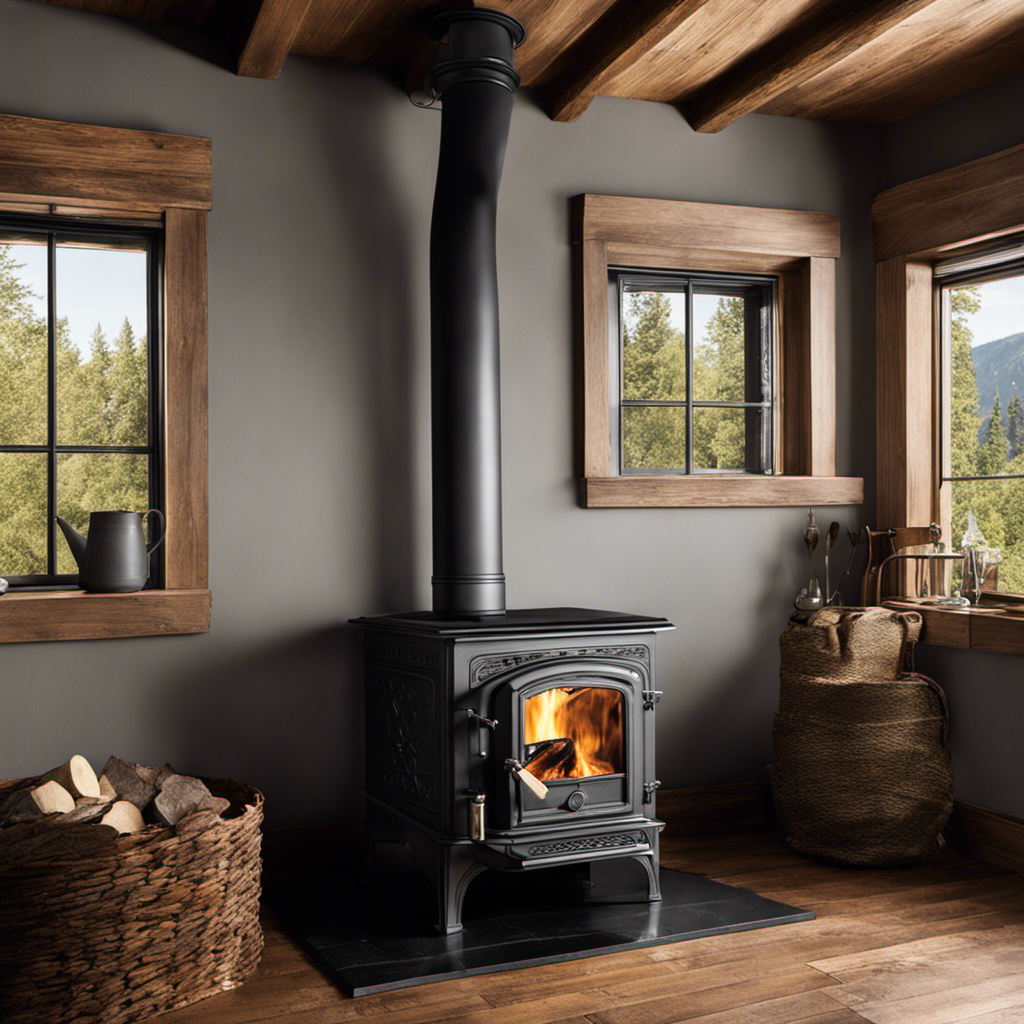I only began to grasp how dirty the glass of my wood stove could become when the fire was no longer visible through it.
Frustrated, I set out to find the best way to clean it.
After trying various methods, I finally discovered the perfect technique.
In this article, I’ll share with you my step-by-step process for cleaning wood stove glass.
From safety precautions to natural cleaners, I’ll cover everything you need to know to keep your wood stove glass crystal clear.
Key Takeaways
- Cleaning wood stove glass is important for optimal heat transfer and to prevent potential hazards.
- Using specialized cleaning products effectively removes stubborn stains and deposits without damaging the glass surface.
- Safety precautions should be taken before cleaning, such as removing flammable materials, ensuring the stove is cool, and providing proper ventilation.
- Gathering the necessary cleaning supplies, including a soft cloth, glass cleaner, and scraper, is essential for effective cleaning.
Why Cleaning Wood Stove Glass Is Important
Cleaning wood stove glass is important because it ensures optimal heat transfer and prevents potential hazards. Regular maintenance of wood stove glass is crucial to maintain its efficiency and safety. Over time, soot, ash, and creosote can accumulate on the glass, obstructing the view of the fire and reducing the stove’s heating capabilities. By regularly cleaning the glass, you can ensure that the heat produced by the fire is effectively radiated into your living space.
Using specialized cleaning products designed specifically for wood stove glass offers several benefits. These products are formulated to effectively remove stubborn stains and deposits without damaging the glass surface. They’re designed to dissolve soot and creosote buildup, making the cleaning process easier and more efficient. Additionally, these specialized cleaning products often contain ingredients that create a protective barrier on the glass, preventing future buildup and making it easier to clean in the future.
Now that we understand the importance of cleaning wood stove glass and the benefits of using specialized cleaning products, it’s crucial to take certain safety precautions before starting the cleaning process.
Safety Precautions Before Cleaning
Before getting started, I should make sure to follow all necessary safety precautions. When it comes to cleaning the wood stove glass, safety should always be a top priority. To begin, I prepare my workspace by removing any flammable materials or objects from the vicinity of the stove. This includes rugs, curtains, or any other items that could potentially catch fire.
Next, I ensure that the stove is completely cool before attempting to clean the glass. This prevents any risk of burns or injuries. When handling cleaning chemicals, it’s important to wear protective gloves to avoid skin irritation or chemical burns. I also make sure to read and follow the instructions provided by the manufacturer on the cleaning product.
Proper ventilation is crucial during the cleaning process, so I open windows or doors to allow fresh air to circulate. Additionally, I keep a fire extinguisher nearby as a precautionary measure. It’s always better to be safe than sorry.
Lastly, I inform others in the household about the cleaning process and advise them to stay away from the stove until the glass is completely clean and the area is safe. Following these safety precautions ensures a smooth and risk-free cleaning experience.
Gathering the Necessary Cleaning Supplies
Before beginning the cleaning process, it’s important to gather all the necessary supplies.
First, make sure to have essential cleaning tools such as a soft cloth, glass cleaner, and a scraper if needed.
Next, familiarize yourself with the proper cleaning techniques for wood stove glass, ensuring a thorough and safe cleaning.
Lastly, choose recommended cleaning products that are specifically designed for removing soot and residue from glass surfaces.
Essential Cleaning Tools
I always make sure to have the necessary tools on hand for cleaning wood stove glass. Efficient cleaning techniques and alternative cleaning methods are essential when it comes to maintaining the clarity and functionality of your wood stove glass. Here is a table outlining the essential cleaning tools that I find most effective:
| Tool | Description |
|---|---|
| Microfiber cloth | Removes dust and debris without scratching the glass surface. |
| Glass cleaner | Specifically designed for removing soot, creosote, and other residues from the glass. |
| Razor blade scraper | Ideal for removing stubborn build-up on the glass surface. |
| Vinegar | A natural alternative to glass cleaner, vinegar helps dissolve tough residues. |
| Newspaper | Provides a streak-free finish when used in combination with glass cleaner or vinegar. |
Proper Cleaning Techniques
To maintain the clarity and functionality of my wood stove, it’s crucial to use proper techniques when cleaning the glass.
The first step is to gather the necessary materials: a soft cloth, a glass cleaner, and a scraper. When choosing a cleaner, I prefer natural options over chemical ones.
Natural cleaners not only protect the environment but also ensure the safety of my family and pets.
Cleaning the glass should be done on a regular basis to prevent the buildup of soot and grime. I find that a weekly cleaning schedule works best for me, but it may vary depending on the frequency of stove use.
Recommended Cleaning Products
Now that we’ve discussed the proper cleaning techniques for wood stove glass, let’s move on to the recommended cleaning products.
When it comes to choosing the right cleaner, you’ve two options: natural or chemical cleaners.
Natural cleaners are a popular choice as they’re environmentally friendly and safe to use around pets and children. These cleaners are typically made from ingredients such as vinegar, baking soda, or lemon juice. They’re effective at removing light soot and residue without damaging the glass surface.
On the other hand, chemical cleaners are specifically formulated to tackle heavy buildup and stubborn stains on wood stove glass. These cleaners often contain ammonia or other strong chemicals that can effectively dissolve and remove tough deposits.
Regardless of the type of cleaner you choose, it’s important to clean your wood stove glass regularly. The frequency of cleaning will depend on how often you use your wood stove. For regular users, cleaning once a week is recommended to prevent buildup and maintain a clear view of the flames.
Removing Soot and Ash Buildup From the Glass
To remove soot and ash buildup from the glass, I find it helpful to first let the glass cool completely.
Then, I use a damp cloth or sponge to gently wipe away the loose particles.
For tougher stains, I recommend using a specialized stove glass cleaner or a mixture of vinegar and water.
Best Cleaning Methods
I’ve found that the best way to clean wood stove glass is by using a mixture of vinegar and water.
This solution is highly effective in removing stubborn soot and ash buildup from the glass surface.
Here are some reasons why this cleaning method is the best:
- Vinegar is a natural and non-toxic cleaner, making it safe to use around your family and pets.
- The acidity of vinegar helps to break down the soot and ash particles, making them easier to wipe away.
- The combination of vinegar and water creates a powerful cleaning solution that effectively cuts through the grime, leaving your wood stove glass sparkling clean.
By following this cleaning technique, you can ensure that your wood stove glass remains clear and free from any buildup.
Now, let’s discuss how to prevent future buildup and maintain the cleanliness of your wood stove glass.
Preventing Future Buildup
To maintain clear and spotless wood stove glass, I always make sure to regularly remove any soot or ash residue. However, preventing future buildup is equally important. One effective method is to prevent condensation on the glass. This can be achieved by adjusting the air intake and ensuring proper ventilation. Additionally, using protective coatings on the glass can help repel soot and ash, making cleaning easier. These coatings create a barrier that prevents buildup from adhering to the glass surface. When choosing a protective coating, it is important to select one that is specifically designed for wood stove glass and can withstand high temperatures. By implementing these preventive measures, you can enjoy a clear view of your wood stove fire without the hassle of frequent cleaning.
| Preventing Condensation | Using Protective Coatings |
|---|---|
| Adjust air intake | Choose a specific coating |
| Ensure proper ventilation | Designed for wood stove glass |
| Withstands high temperatures |
Using Natural Cleaners for a Chemical-Free Option
I prefer using natural cleaners for a chemical-free option when cleaning the wood stove glass. Natural cleaning solutions not only provide a safer alternative to chemical cleaners but also offer a range of benefits for both our health and the environment.
Here are some reasons why I believe natural cleaning solutions are the best choice:
-
Safer for our health: Chemical cleaners often contain harsh ingredients that can irritate our skin, eyes, and respiratory system. Natural cleaners, on the other hand, are made from non-toxic ingredients such as vinegar, lemon juice, or baking soda, which are gentle yet effective in removing grime and soot from the glass.
-
Environmentally friendly: Chemical cleaners can release harmful fumes into the air and contaminate water sources when disposed of improperly. Natural cleaners are biodegradable and don’t contribute to pollution, making them a more sustainable choice for cleaning our wood stove glass.
-
Cost-effective: Natural cleaning solutions are often readily available in our homes, such as vinegar or baking soda, which can save us money on expensive chemical cleaners. Additionally, these natural options can be used for multiple cleaning tasks, making them versatile and economical.
Preventing Future Buildup on the Glass
To prevent future buildup on the glass, I make sure to regularly wipe it down with a microfiber cloth. This simple step helps to keep the glass clean and clear, allowing for better visibility of the fire inside the wood stove. In addition to regular cleaning, there are a few other measures that can be taken to prevent condensation and the formation of hard water stains on the glass.
One effective method is to use a dehumidifier in the room where the wood stove is located. This helps to reduce the overall moisture content in the air, which in turn can help to prevent condensation on the glass. Another option is to crack open a window slightly while the wood stove is in use. This allows for better airflow and can help to prevent the buildup of moisture on the glass.
To further protect the glass, it is also recommended to use a wood stove glass cleaner. These cleaners are specifically formulated to remove hard water stains and other buildup from the glass surface. Simply spray the cleaner onto the glass and wipe it away with a clean cloth or sponge.
By incorporating these preventive measures into your wood stove maintenance routine, you can ensure that the glass remains clear and free from buildup, providing a better view of the fire and enhancing the overall enjoyment of your wood stove experience.
| Preventive Measures | Steps to Follow |
|---|---|
| Regularly wipe down the glass with a microfiber cloth | – Dampen the cloth with water or a wood stove glass cleaner. – Gently wipe the glass in circular motions. – Repeat as necessary. |
| Use a dehumidifier in the room | – Place the dehumidifier in a central location. – Set the humidity level to a comfortable range. – Empty the water reservoir regularly. |
| Crack open a window while the wood stove is in use | – Open the window slightly to allow for airflow. – Adjust the window position to balance temperature and moisture. – Close the window when the wood stove is not in use. |
| Use a wood stove glass cleaner | – Spray the cleaner onto the glass surface. – Allow the cleaner to sit for a few minutes. – Wipe away the cleaner with a clean cloth or sponge. |
Cleaning the Exterior of the Wood Stove
When it comes to maintaining my wood stove, I always ensure the exterior remains spotless by regularly wiping it down with a damp cloth. This not only keeps it looking clean and polished, but it also helps to prevent any dirt or debris from getting inside the stove. However, cleaning the exterior is just one part of the maintenance process.
To keep my wood stove in the best condition possible, I also make sure to clean the interior and remove any rust stains that may have developed over time. To clean the interior of my wood stove, I first remove all the ashes and debris from the firebox. I use a small brush and dustpan to carefully sweep out any remaining ashes.
Next, I mix a solution of warm water and mild dish soap. Using a scrub brush, I gently scrub the interior surfaces, paying special attention to any areas with rust stains. Once the rust stains are removed, I rinse the interior with clean water and dry it thoroughly.
In addition to cleaning the interior, I also take steps to remove any rust stains that may have appeared on the exterior of my wood stove. I use a mixture of vinegar and baking soda to create a paste. Then, I apply the paste to the rust stains and let it sit for about 15 minutes. Afterward, I scrub the stains with a soft brush and rinse off the paste. This method effectively removes the rust stains and restores the exterior of my wood stove to its original condition.
Maintaining a Regular Cleaning Routine
To keep my wood stove glass clean and clear, I have established a regular cleaning routine. By maintaining frequency in my cleaning process, I ensure that the glass remains spotless and allows me to enjoy the mesmerizing flames inside the stove.
Here is my cleaning routine, which I follow religiously:
| Frequency | Cleaning Process |
|---|---|
| Weekly | Wipe the glass with a damp cloth to remove any loose residue |
| Monthly | Use a glass cleaner specifically designed for wood stoves to remove stubborn stains |
| Seasonal | Perform a deep clean by removing the glass and cleaning it with a glass-cleaning solution and a soft brush |
By cleaning the glass weekly, I prevent the buildup of soot and ash, which can become difficult to remove over time. Additionally, the monthly cleaning with a specialized glass cleaner ensures that any tough stains are eliminated.
Maintaining this regular cleaning routine not only keeps the glass looking pristine but also extends its lifespan by preventing etching and corrosion.
With a well-maintained cleaning routine, I rarely encounter any issues. However, in the next section, I will discuss common cleaning issues that may arise and how to troubleshoot them effectively. Transitioning into the subsequent section, let’s explore troubleshooting common cleaning issues.
Troubleshooting Common Cleaning Issues
I often encounter challenges when removing stubborn stains or residue from my wood stove’s glass. It can be frustrating and time-consuming to try and clean it properly. However, with some troubleshooting and efficient cleaning tips, you can tackle these common issues and have your wood stove glass looking crystal clear in no time.
Here are some tips to help you troubleshoot and efficiently clean your wood stove glass:
-
Use the right cleaning solution:
- Mix equal parts water and vinegar for a natural cleaning solution.
- Avoid using abrasive cleaners that can scratch the glass.
- If the stains are particularly stubborn, try using a commercial stove glass cleaner.
-
Scrub gently:
- Use a non-abrasive sponge or cloth to scrub the glass.
- Apply the cleaning solution and let it sit for a few minutes before scrubbing.
- Avoid using excessive force, as it can damage the glass.
-
Prevent future buildup:
- Regularly clean your wood stove glass to prevent excessive build-up.
- Monitor the quality of your firewood to avoid excessive smoke and soot.
- Consider using a glass cleaner designed specifically for wood stoves.
Frequently Asked Questions
Can I Use Regular Glass Cleaner to Clean the Wood Stove Glass?
Yes, you can use regular glass cleaner to clean the wood stove glass. However, it’s important to note that using vinegar as an alternative cleaner is a better option.
When cleaning hot wood stove glass, always take precautions to avoid burns. Allow the glass to cool down before cleaning, and wear protective gloves.
Regularly cleaning the wood stove glass will help maintain its clarity and prevent build-up of soot and residue.
How Often Should I Clean the Wood Stove Glass?
Cleaning the wood stove glass is an essential task to keep it looking clear and functioning efficiently. To prevent the glass from getting dirty, it’s recommended to clean it regularly. The frequency of cleaning will depend on how often you use the wood stove.
As for the best cleaning methods, avoid using regular glass cleaners as they may contain chemicals that can damage the glass. Instead, opt for a specialized stove glass cleaner or a mixture of vinegar and water for a natural solution.
Is It Safe to Clean the Glass While the Wood Stove Is Still Hot?
It’s important to take safety precautions when cleaning hot wood stove glass.
Cleaning the glass while the stove is still hot can be dangerous, as it can cause burns or injuries. It’s recommended to wait until the stove has cooled down before attempting to clean the glass.
Alternatively, you can use specific cleaning products designed for cleaning hot glass surfaces or opt for natural alternatives such as vinegar and water solution.
Always prioritize safety when cleaning wood stove glass.
What Should I Do if the Glass Becomes Cloudy After Cleaning?
To prevent the wood stove glass from becoming cloudy after cleaning, there are a few steps I follow.
First, I make sure the glass is completely cool before cleaning.
Then, I use a specialized cleaning product designed for wood stove glass. I spray the product onto a microfiber cloth and gently wipe the glass in a circular motion.
Finally, I buff the glass with a clean, dry cloth to remove any streaks.
This method ensures a crystal-clear and cloud-free wood stove glass.
Can I Use Abrasive Materials to Remove Stubborn Buildup on the Glass?
Using abrasive materials on wood stove glass can cause permanent damage. Instead, I recommend cleaning wood stove glass without using abrasive materials.
Here’s a safe and effective method:
- Mix equal parts vinegar and water in a spray bottle.
- Spray the mixture onto the glass and let it sit for a few minutes.
- Then, gently scrub the glass with a non-abrasive sponge or cloth.
- Rinse thoroughly and dry with a clean, lint-free cloth.
This method will leave your wood stove glass clean and clear without any damage.
Conclusion
In conclusion, regular cleaning of your wood stove glass is essential for maintaining its efficiency and ensuring a safe and enjoyable burning experience.
While some may argue that cleaning can be time-consuming, imagine the satisfaction of looking through crystal-clear glass and seeing the warm glow of a well-maintained fire.
By following the steps outlined in this article and incorporating a regular cleaning routine, you can keep your wood stove glass looking pristine and enhance the overall ambiance of your home.











